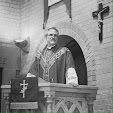I was watching an episode of a BBC program in which British comedian and actor Stephen Fry (who played Jeeves opposite Hugh Laurie's Wooster in the TV adaptation of (the uproariously funny and brilliant) Jeeves and Wooster) visits all fifty states of the American union. In this episode, Fry travels up the Mississippi River from New Orleans to Minnesota.
I was interested in how he would find Louisiana - especially New Orleans. Of course, there is only so much one can see in a short time, and even less that will survive the cutting room floor. Basically, Fry visited Bourbon Street on Mardi Gras, interviewed an alleged voodoo priestess (a white Jewish lady from New England, actually), and toured the Angola prison.
That was it.
His conclusions were as fake as the New Orleans accents in the movie The Big Easy. Laughably so! Of course, the whole Mardi Gras on Bourbon Street thing is a gross distortion of what Carnival is really like. It's like summarizing American cuisine by showing a kid eating chicken nuggets at McDonald's. Yes, you will find Americans doing so, but it's a rather narrow stereotype of a much bigger totality. And in fairness, Bourbon Street is a tourist area that caters to tourists and is filled with tourists. It's a little like visiting Chinatown and concluding that the average American speaks fluent Mandarin. Great story, shame about the facts.
But it makes for sensationalistic TV I suppose.
The really laughable part was the time wasted on the whole "voodoo priestess" thing. I mean, really! Fry went so far as to conclude that voodoo is the spiritual bedrock of New Orleans. Can he actually believe this? Of course, there were (and perhaps still are) real practitioners of voodoo. But what you find in the French Quarter are souvenir shops and (once again) tourist traps. Moreover, the overwhelming spirituality of New Orleanians - even if only in a cultural or nominal way - is Roman Catholicism - so much so that the poster advertising the most recent LCMS Youth Gathering featured the Roman Catholic Cathedral of St. Louis (the spiritual hub of New Orleans) as part of its logo. But to watch this show, one would think that Christianity runs a distant second to voodoo, that your average Louisianian carries his car keys on a real shrunken head, and sticking pins in effigies of rival football coaches (well, the last one might be true... just kidding). Actually, the real spirituality of New Orleans is indeed football - the Saints, LSU, Tulane, and your various and sundry Alabama fans. It is impossible to walk around New Orleans for any length of time without seeing a Saints jersey or a billboard with Drew Brees's picture on it. A close second in the hearts of the local culture involves the lifestyle that focuses on music and restaurants (both with an authentic regional uniqueness) - quite independent of both Mardi Gras and Bourbon Street. But Fry chose to focus on something as arcane as voodoo. And of course, Angola Prison.
Boy, they saw him coming!
Obviously, the screenwriters had in mind a very shallow stereotypical and preconceived picture of Louisiana, and seized on it: Bourbon Street Mardi Gras, voodoo, and a prison. There was an obligatory tour of the post-Katrina Ninth Ward - but of course, the impression was given that only black neighborhoods suffered under Hurricane Katrina (because of the implied conclusion that the population of Louisiana is racist - yet more sensationalism that can be disproved by even a cursory real visit).
In contrast to the hackneyed Fry job, here is a story from our local paper that you might not hear about in the rest of the country and world - a piece that captures the big-heartedness and sense of community that maybe isn't quite as compelling as voodoo. But it does involve Mardi Gras, though if you're looking for vomit-stained college girls from the midwest exposing themselves, or chickens being sacrificed, or lurid scenes of prisoners being marched around by rifle-toting guards - you will be disappointed. It does, however, demonstrate what the vast majority of real New Orleanians think of drunken knuckleheads at the local parades and how children (especially the handicapped) fit into our complex and cosmopolitan culture.
I think the headline in the print edition sums it up: That's How We Roll.
It's too bad that Stephen Fry didn't dig a little deeper. For the real Louisiana is way more interesting, intricate, incongruous, and intimate than his producers' limp and lazy attempt to create a lurid, and yet ultimately, plastic (and boring!) image that is more imagination than reality.


1 comment:
great observations Fr. H... now, go and cleanse your palate by re-reading some Wodehouse
Post a Comment